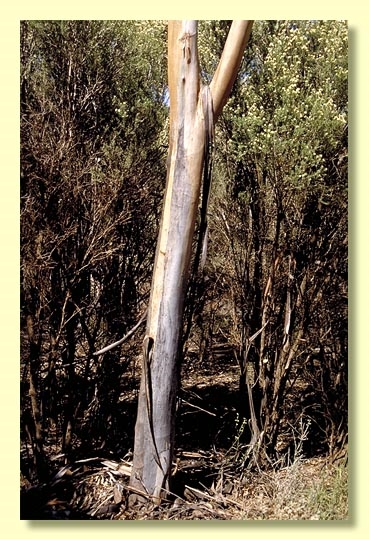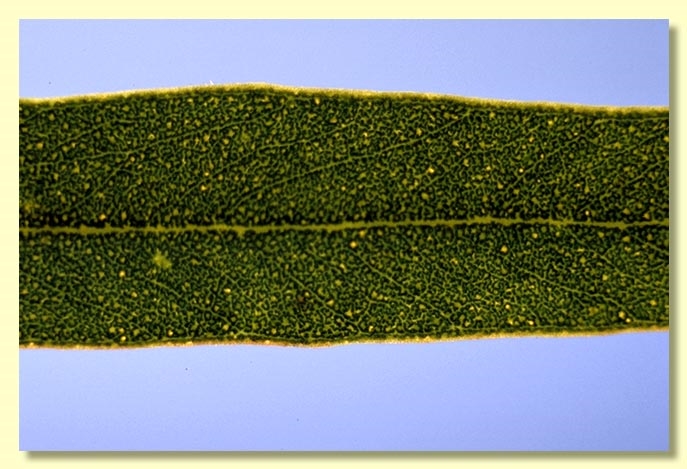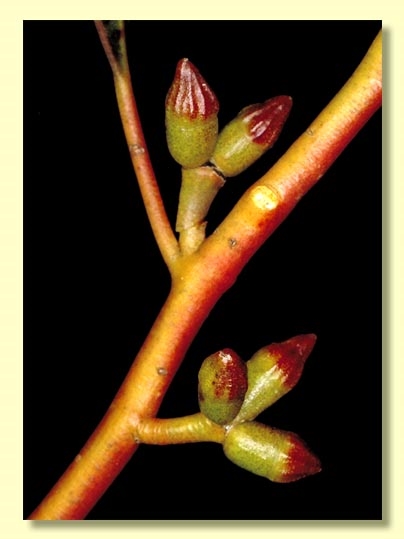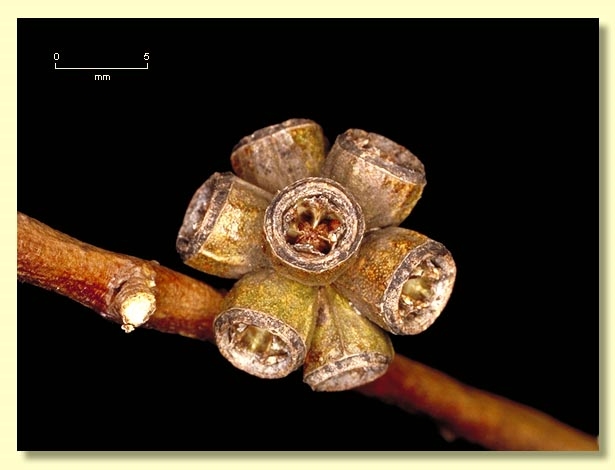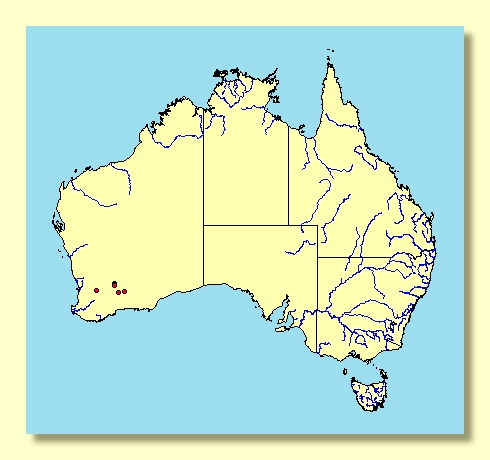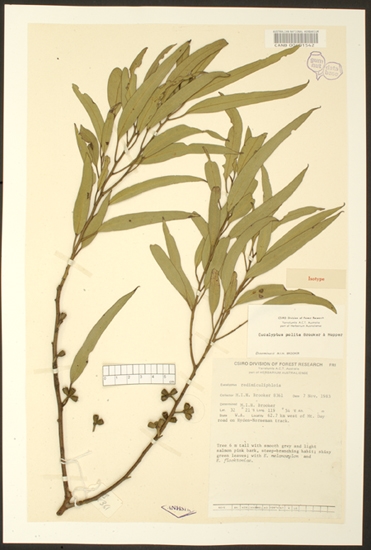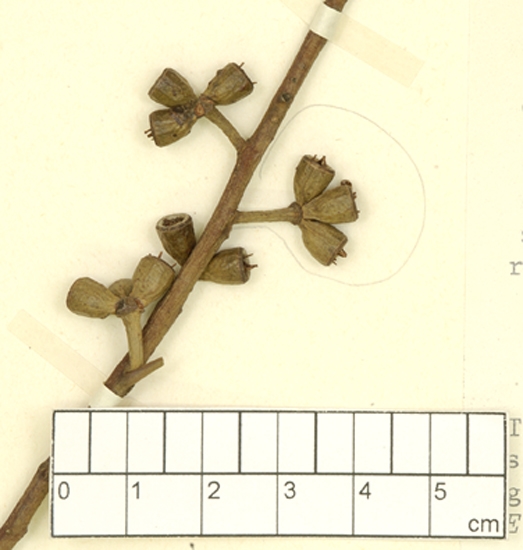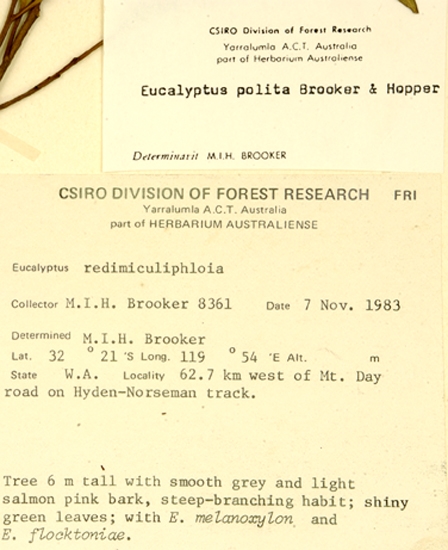Eucalyptus | Symphyomyrtus | Dumaria | Rufispermae
Euclid - Online edition
Eucalyptus polita
Bark smooth throughout, pale and dark grey over orange, shedding in long ribbons.
Branchlets non-glaucous; pith oil glands present.
Juvenile growth (coppice or field seedlings to 50 cm): stems rounded in cross-section; juvenile leaves always petiolate, alternate, narrowly lanceolate to lanceolate, 5.5–10 cm long, 0.8–2 cm wide, dull, green.
Adult leaves alternate, petioles 1–2 cm long; blade narrowly lanceolate, 7–12 cm long, 0.7–1.5 cm wide, base tapering to petiole, margin entire, apex pointed, concolorous, glossy, green, side-veins at an acute or wider angle to midrib, reticulation very dense, intramarginal vein present, oil glands intersectional.
Inflorescence axillary unbranched, peduncles 0.4–1 cm long, flattened or angular; buds 7, 9 or 11, sessile to very shortly pedicellate, pedicels 0–0.1 cm long. Mature buds small, ovoid to ± cylindrical (0.6–0.7 cm long, 0.4 cm wide), scar present, operculum conical (0.3 cm long), sometimes slightly wider than the hypanthium, radially striate, stamens inflexed, anthers cuboid to wedge-shaped, versatile, dorsifixed, dehiscing by longitudinal slits, style long and straight, stigma blunt to rounded, locules 3 or 4, the placentae each with 4 vertical rows of ovules. Flowers white.
Fruit sessile to very shortly pedicellate, pedicels 0–0.1 cm long, cupular to almost obconical, 0.4–0.5 cm long, 0.4–0.7 cm wide, disc descending, valves 3 or 4, near rim level or slightly exserted due to persistent style fragments.
Seeds reddish brown and glossy, 0.8–2.5 mm long, flattened-ovoid with the outline often angular, dorsal surface sometimes lacunose, shallowly reticulate, hilum ventral.
Cultivated seedlings (measured at node 10): cotyledons reniform; stems square in cross-section, sometimes slightly glaucous; leaves always petiolate, opposite for 3 to 5 nodes then alternate, ovate, 5–8 cm long, 2–4 cm wide, dull, green.
Flowering time unknown.
A small tree (mallet) endemic to the southern Goldfields area of Western Australia, from Forrestania north to near Marvel Loch, on brown calcareous loam, often stony. The trunk is smooth-barked, the adult leaves are glossy green and the buds small and sessile or virtually so.
In the classification of Brooker (2000) Eucalyptus polita belongs in Eucalyptus subgenus Symphyomyrtus section Dumaria having these features: buds initially with two opercula the outer shed early, stamens strongly inflexed, ovules in 4 rows on the placentae and cotyledons reniform. Within section Dumaria the species belongs to a large sub-group of closely related species (series Rufispermae, 37 described species and subspecies) diagnosed by glandular pith in the branchlets, cuboid to wedge shaped versatile anthers, and by the reddish brown and glossy, flattish seeds which are unique to the series.
Compared with other series Rufispermae species found in this general area E. polita is like a slender, smooth-barked form of the Blackbutt, E. kondininensis, sharing the narrow, glossy adult leaves, virtually sessile, small, striate buds and cupular fruit. Both these species lack the white waxiness of E. vittata, E. sheathiana and E. clelandii. The tall slender mallet habit and usually sessile buds of E. polita contrast with the low-branching mallet habit and pedicellate and longer buds of the related E. spreta. Another related, non-glaucous, glossy-leaved, small-budded species, E. phenax subsp. phenax, differs in being a mallee, having buds 0.7-1.1 cm long on pedicels 0-0.3 cm long. The more recently described mallet E. distuberosa also differs from E. polita in having buds and fruit alway pedicellate (pedicels 0.2-0.7 cm long) and longer fruit.


